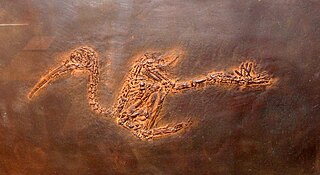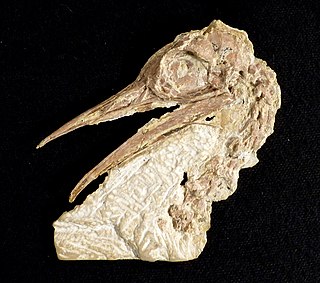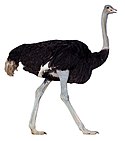
Caudipteryx is a genus of small oviraptorosaur dinosaurs that lived in Asia during the Early Cretaceous, around 124.6 million years ago. They were feathered and extremely birdlike in their overall appearance, to the point that some paleontologists suggested it was a bird. Two species have been described: C. zoui, in 1998, and C. dongi, in 2000.

Confuciusornis is a genus of basal crow-sized avialan from the Early Cretaceous Period of the Yixian and Jiufotang Formations of China, dating from 125 to 120 million years ago. Like modern birds, Confuciusornis had a toothless beak, but closer and later relatives of modern birds such as Hesperornis and Ichthyornis were toothed, indicating that the loss of teeth occurred convergently in Confuciusornis and living birds. It was thought to be the oldest known bird to have a beak, though this title now belongs to an earlier relative Eoconfuciusornis. It was named after the Chinese moral philosopher Confucius. Confuciusornis is one of the most abundant vertebrates found in the Yixian Formation, and several hundred complete specimens have been found.

Fossil Butte National Monument is a United States National Monument managed by the National Park Service, located 15 miles (24 km) west of Kemmerer, Wyoming, United States. It centers on an assemblage of Eocene Epoch animal and plant fossils associated with Fossil Lake—the smallest lake of the three great lakes which were then present in what are now Wyoming, Utah, and Colorado. The other two lakes were Lake Gosiute and Lake Uinta. Fossil Butte National Monument was established as a national monument on October 23, 1972.

Palaeognathae is an infraclass of birds, called paleognaths or palaeognaths, within the class Aves of the clade Archosauria. It is one of the two extant infraclasses of birds, the other being Neognathae, both of which form Neornithes. Palaeognathae contains five extant orders consisting of four flightless lineages, termed ratites, and one flying lineage, the Neotropic tinamous. There are 47 species of tinamous, five of kiwis (Apteryx), three of cassowaries (Casuarius), one of emus (Dromaius), two of rheas (Rhea) and two of ostriches (Struthio). Recent research has indicated that paleognaths are monophyletic but the traditional taxonomic split between flightless and flighted forms is incorrect; tinamous are within the ratite radiation, meaning flightlessness arose independently multiple times via parallel evolution.

Limnofregata is an extinct genus of primitive frigatebird. The two known species were described after fossils from the Early Eocene Green River Formation of Wyoming. A number of good complete and partial skeletons, some with feather impressions, are known of the type species, Limnofregata azygosternon, and L. hasegawai is known from two skulls and most of one torso.
Limenavis is a genus of ornithuran dinosaurs from the Late Cretaceous. It lived about 70 million years ago, around the Campanian-Maastrichtian boundary. Known from several broken bones, the remains of the only known species Limenavis patagonica were found in rocks of the "lower member" of the Allen Formation at Salitral Moreno, 20 km south of General Roca, Río Negro (Argentina). It is one of the closest relatives, in the fossil record, of the modern birds.

The Fur Formation is a marine geological formation of Ypresian age which crops out in the Limfjord region of northern Denmark from Silstrup via Mors and Fur to Ertebølle, and can be seen in many cliffs and quarries in the area. The Diatomite Cliffs is on the Danish list of tentative candidates for World Heritage and may become a World Heritage site. Fossils found in the Fur Formation are primarily housed at the Fossil and Mo-clay Museum on Mors Island, the Fur Museum on Fur Island, and the Natural History Museum of Denmark in Copenhagen.

Rhynchaeites is an extinct genus of wading bird, a stem-group threshkiornithid, from the Eocene. It is one of the oldest members of the ibis family known from fossil remains.

Lithornis is a genus of extinct paleognathous birds. Although Lithornis was able to fly well, their closest relatives are the extant tinamous and ratites.

Lithornithidae is an extinct, possibly paraphyletic group of early paleognath birds. They are known from fossils dating to the Upper Paleocene through the Middle Eocene of North America and Europe, with possible Late Cretaceous representatives. All are extinct today; the youngest specimen is the currently unnamed SGPIMH MEV1 specimen from the mid-Eocene Messel Pit site.
Paracathartes is a genus of extinct bird from the Wasachtian horizon of lower Eocene Wyoming. One species, Paracathartes howardae has been described.

Pseudocrypturus is a genus of extinct paleognathous bird. One species is known, Pseudocrypturus cercanaxius. It is a relative of such modern birds as ostriches. It lived in the early Eocene. The holotype fossil is in the collection of the Smithsonian's National Museum of Natural History. It has catalog number USNM 336103. It was collected from the Fossil Butte Member, Green River Formation, Lincoln County, Wyoming.

Asterotrygon is an extinct genus of stingray from the Eocene Green River Formation in Wyoming. Several complete skeletons representing juveniles, adults, males and females have been uncovered from the late early Eocene Fossil Butte Member of the formation. The type and only species, A. maloneyi, was named in 2004 on the basis of these fossils. Another stingray, Heliobatis, is also known from the formation. Asterotrygon is a primitive stingray closely related to the living family Urolophidae whose ancestors likely originated in the Indo-Pacific. It lived in Fossil Lake, a body of water that existed in a subtropical mountainous region for only about 2 million years.

Archaeopteryx fossils from the quarries of Solnhofen limestone represent the most famous and well-known fossils from this area. They are highly significant to paleontology and avian evolution in that they document the fossil record's oldest-known birds.

Galeamopus is a genus of herbivorous diplodocid sauropod dinosaurs. It contains two known species: Galeamopus hayi, known from the Late Jurassic lower Morrison Formation of Wyoming, United States, and Galeamopus pabsti, known from the Late Jurassic fossils from Wyoming and Colorado. The type species is known from one of the most well preserved diplodocid fossils, a nearly complete skeleton with associated skull.

Julia Allison Clarke is an American paleontologist and evolutionary biologist who studies the evolution of birds and the dinosaurs most closely related to living birds. She is the John A. Wilson Professor in Vertebrate Paleontology in the Jackson School of Geosciences and a Howard Hughes Medical Institute Professor at the University of Texas at Austin.

The Edmontosaurus mummy SMF R 4036 is an exceptionally well-preserved dinosaur fossil in the collection of the Naturmuseum Senckenberg (SM) in Frankfurt am Main, Germany. Found in 1910 in Wyoming, United States, it is ascribed to the species Edmontosaurus annectens, a member of the Hadrosauridae. The fossil comprises a nearly complete skeleton that was found wrapped in impressions of its skin, a rare case of exceptional preservation for which the term "dinosaur mummy" has been used. Notably, the horny beak is preserved with this specimen. Plant remains found within the thorax cavity had been interpreted as stomach contents, although later research questioned this identification. The mummy's hands are wrapped in skin impression, which was interpreted as evidence for interdigital webbing and an aquatic lifestyle in hadrosaurids; this hypothesis, although universally accepted once, is now widely refused. SMF R 4036 is one of the four best preserved hadrosaurid mummies, and was the second to be discovered. The find was made by fossil hunter Charles Hazelius Sternberg and his sons, who sold their numerous finds to various museums in North America and Europe. Only two years earlier the Sternbergs had discovered the Edmontosaurus mummy AMNH 5060 in the same region, which is now on display at the American Museum of Natural History (AMNH) in New York City.
Eocypselus rowei is an extinct bird believed to be ancestral to modern hummingbirds and swifts. It was a small bird, less than 5 in (13 cm) in length, and probably had black feathers. The bird was first described in 2013 and lived approximately 50 million years ago, during the Eocene epoch.

Tonsala is an extinct genus of Plotopteridae, a family of flightless seabird similar in biology with penguins, but more closely related to modern cormorants. The genus is known from terrains dated from the Late Oligocene of the State of Washington and Japan.

Paakniwatavis is a genus of extinct waterfowl from the early Eocene Green River Formation of Wyoming, United States. The genus contains a single species, P. grandei, known from a partial skeleton with a skull.



















